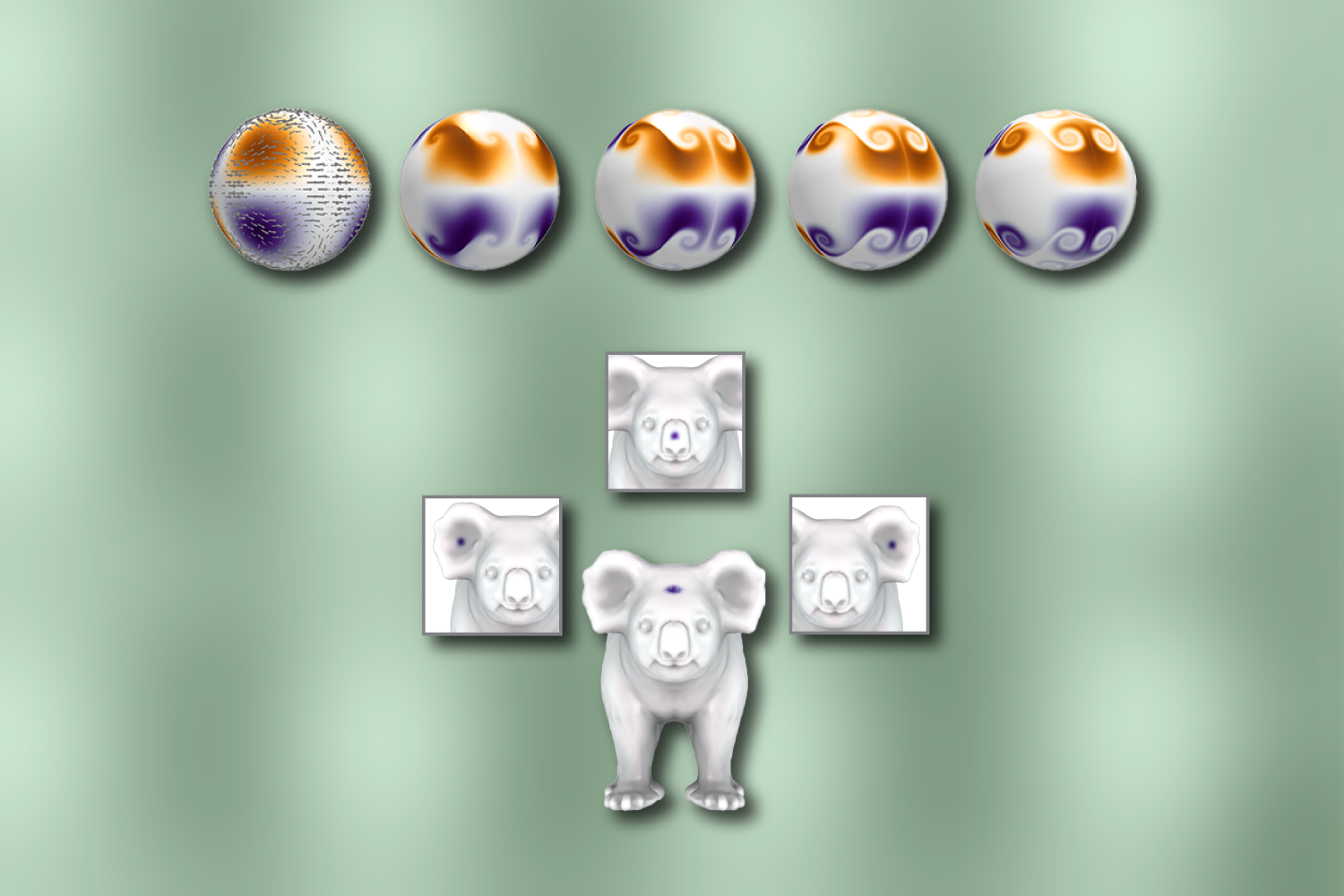
Computer graphics and geometry processing research provide the tools needed to simulate physical phenomena like fire and flames, aiding the creation of visual effects in video games and movies as well as the fabrication of complex geometric shapes using tools like 3D printing.
Under the hood, mathematical problems called partial differential equations (PDEs) model these natural processes. Among the many PDEs used in physics and computer graphics, a class called second-order parabolic PDEs explain how phenomena can become smooth over time. The most famous example in this class is the heat equation, which predicts how heat diffuses along a surface or in a volume over time.
Researchers in geometry processing have designed numerous algorithms to solve these problems on curved surfaces, but their methods often apply only to linear problems or to a single PDE. A more general approach by researchers from MIT’s Computer Science and Artificial Intelligence Laboratory (CSAIL) tackles a general class of these potentially nonlinear problems.
In a paper recently published in the Transactions on Graphics journal and presented at the SIGGRAPH conference, they describe an algorithm that solves different nonlinear parabolic PDEs on triangle meshes by splitting them into three simpler equations that can be solved with techniques graphics researchers already have in their software toolkit. This framework can help better analyze shapes and model complex dynamical processes.
“We provide a recipe: If you want to numerically solve a second-order parabolic PDE, you can follow a set of three steps,” says lead author Leticia Mattos Da Silva SM ’23, an MIT PhD student in electrical engineering and computer science (EECS) and CSAIL affiliate. “For each of the steps in this approach, you’re solving a simpler problem using simpler tools from geometry processing, but at the end, you get a solution to the more challenging second-order parabolic PDE.”
To accomplish this, Da Silva and her coauthors used Strang splitting, a technique that allows geometry processing researchers to break the PDE down into problems they know how to solve efficiently.
First, their algorithm advances a solution forward in time by solving the heat equation (also called the “diffusion equation”), which models how heat from a source spreads over a shape. Picture using a blow torch to warm up a metal plate — this equation describes how heat from that spot would diffuse over it. This step can be completed easily with linear algebra.
Now, imagine that the parabolic PDE has additional nonlinear behaviors that are not described by the spread of heat. This is where the second step of the algorithm comes in: it accounts for the nonlinear piece by solving a Hamilton-Jacobi (HJ) equation, a first-order nonlinear PDE.
While generic HJ equations can be hard to solve, Mattos Da Silva and coauthors prove that their splitting method applied to many important PDEs yields an HJ equation that can be solved via convex optimization algorithms. Convex optimization is a standard tool for which researchers in geometry processing already have efficient and reliable software. In the final step, the algorithm advances a solution forward in time using the heat equation again to advance the more complex second-order parabolic PDE forward in time.
Among other applications, the framework could help simulate fire and flames more efficiently. “There’s a huge pipeline that creates a video with flames being simulated, but at the heart of it is a PDE solver,” says Mattos Da Silva. For these pipelines, an essential step is solving the G-equation, a nonlinear parabolic PDE that models the front propagation of the flame and can be solved using the researchers’ framework.
The team’s algorithm can also solve the diffusion equation in the logarithmic domain, where it becomes nonlinear. Senior author Justin Solomon, associate professor of EECS and leader of the CSAIL Geometric Data Processing Group, previously developed a state-of-the-art technique for optimal transport that requires taking the logarithm of the result of heat diffusion. Mattos Da Silva’s framework provided more reliable computations by doing diffusion directly in the logarithmic domain. This enabled a more stable way to, for example, find a geometric notion of average among distributions on surface meshes like a model of a koala.
Even though their framework focuses on general, nonlinear problems, it can also be used to solve linear PDE. For instance, the method solves the Fokker-Planck equation, where heat diffuses in a linear way, but there are additional terms that drift in the same direction heat is spreading. In a straightforward application, the approach modeled how swirls would evolve over the surface of a triangulated sphere. The result resembles purple-and-brown latte art.
The researchers note that this project is a starting point for tackling the nonlinearity in other PDEs that appear in graphics and geometry processing head-on. For example, they focused on static surfaces but would like to apply their work to moving ones, too. Moreover, their framework solves problems involving a single parabolic PDE, but the team would also like to tackle problems involving coupled parabolic PDE. These types of problems arise in biology and chemistry, where the equation describing the evolution of each agent in a mixture, for example, is linked to the others’ equations.
Mattos Da Silva and Solomon wrote the paper with Oded Stein, assistant professor at the University of Southern California’s Viterbi School of Engineering. Their work was supported, in part, by an MIT Schwarzman College of Computing Fellowship funded by Google, a MathWorks Fellowship, the Swiss National Science Foundation, the U.S. Army Research Office, the U.S. Air Force Office of Scientific Research, the U.S. National Science Foundation, MIT-IBM Watson AI Lab, the Toyota-CSAIL Joint Research Center, Adobe Systems, and Google Research.